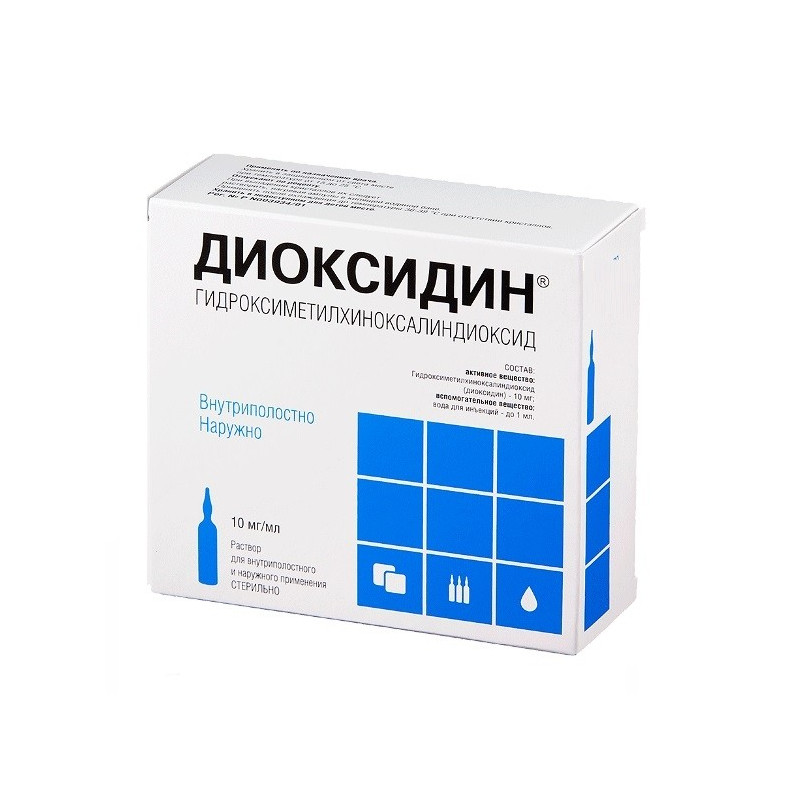



 All payments are encrypted via SSL
All payments are encrypted via SSL
 Full Refund if you haven't received your order
Full Refund if you haven't received your order
- purulent bacterial infections caused by sensitive microflora with the ineffectiveness of other chemotherapeutic agents or their poor tolerance.
Outdoor use
- superficial and deep wounds of various localization;
- nonhealing wounds and trophic ulcers;
- soft tissue phlegmon;
- infected burns;
- purulent wounds with osteomyelitis.
Intracavitary injection
- purulent processes in the chest and abdominal cavity;
- with purulent pleurisy, empyema, lung abscesses, peritonitis, cystitis, wounds with the presence of deep purulent cavities (soft tissue abscesses, phlegmon of the pelvic fiber, postoperative wounds of the urinary and biliary ducts, purulent mastitis).
Dosing regimen
Dioxidine prescribed in the hospital. Apply externally, intracavitary.
Dioxidine 1% solution cannot be used for intravenous administration, due to the instability of the solution during storage at low temperatures.
Outdoor use
Apply 0.1-1% Dioxidine solutions. To obtain a 0.1-0.2% solution, the ampoule solutions of the drug are diluted to the desired concentration with sterile isotonic sodium chloride solution or water for injection.
For treatment of superficial infected purulent wounds Apply to the wound wipes moistened with 0.5 -1% dioxidine solution. Deep wounds after treatment, loosely tamped with tampons moistened with 1% dioxidine solution, and in the presence of a drainage tube, from 0.5 to 100 ml of a 0.5% solution of the preparation is injected into the cavity.
For treatment of deep purulent wounds with osteomyelitis (wounds of the hand, foot) apply 0.5-1% solutions of the preparation in the form of trays or carry out special treatment of the wound with a solution of the preparation for 15-20 minutes (introduction of a solution into the wound for this period), followed by application of dressings with 1% dioxidine solution.
Dioxidine in the form of 0.1-0.5% solutions can be used for prevention of infection after surgery. According to indications (patients with osteomyelitis) and with good tolerance, treatment can be carried out daily for 1.5-2 months.
Intracavitary injection
Depending on its size, 10-50 ml of 1% dioxidine solution / day is injected into the purulent cavity. The dioxidine solution is injected into the cavity through a catheter, a drainage tube or a syringe.
The maximum daily dose for the introduction into the cavity of 70 ml of 1% solution.
The drug is injected into the cavity usually 1 time / day. According to indications, it is possible to introduce a daily dose in two doses. With good portability and availability of evidence, the drug can be administered daily for 3 weeks or more. If necessary, in 1-1.5 months they conduct repeated courses.
With intracavitary administration, headache, chills, fever, dyspeptic disorders, muscle cramping, allergic reactions, photosensitizing effect (the appearance of pigmented spots on the body when exposed to sunlight) are possible.
When applied externally, near-edge dermatitis.
- adrenal insufficiency (including history);
- pregnancy;
- lactation period;
- childhood;
- Hypersensitivity to dioxidine.
WITH caution - renal failure.
Contraindicated in pregnancy and lactation.
Application for violations of kidney function
WITH caution - renal failure. In chronic renal failure, the dose is reduced.
Dioxidine is prescribed only for adults. Before starting the course of treatment, a test is carried out on the tolerability of the drug, for which 10 ml of a 1% solution is injected into the cavities. If there are no side effects (dizziness, chills, fever) within 3-6 hours, they begin a course of treatment.
Dioxidine is prescribed only for severe forms of infectious diseases or for the ineffectiveness of other antibacterial drugs, including cephalosporins II-IV generations, fluoroquinolones, carbapenems.
In chronic renal failure, the dose is reduced.
When pigment spots appear, increase the duration of a single dose to 1.5-2 hours, reduce the dose, prescribe antihistamines, or cancel Dioxidine.
In case of dioxidine crystals falling out in ampoules with a solution during storage (at a temperature below 15 ° C), they are dissolved by heating the ampoules in a boiling water bath with shaking until the crystals completely dissolve (clear solution).If during cooling to 36-38 ° С crystals do not fall out again, the preparation is usable.
Storage conditions
List B. Keep out of the reach of children, protected from light at a temperature of 18 ° to 25 ° C.
